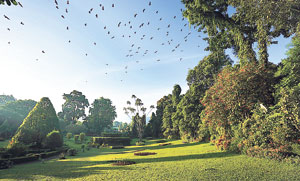We Lankans tend to take our island’s lush abundance of green for granted. True there is renewed interest in gardening, in creating cool spaces in our urban sprawl, but we so often overlook the tiny orchid in the wild or the towering majesty of an old gnarled tree and are not easily given to seeing gardens as objects of rare beauty.
A new coffee-table book, Gardens of Lanka edited by Sarala Fernando with photography by Luxshmanan Nadaraja, is a joyous celebration of gardens ancient and new taking us back through the mists of history to look afresh at a heritage that has been little recognized except by archaeologists and historians. Yet it was all there even if we failed to see it. Wasn’t it in a grove of mango trees that Arahat Mahinda met King Tissa in the 3rd Century BC? Don’t we see contemporary examples of water features in ancient sites - Lotus ponds in Polonnaruwa and water fountains in Sigiriya? Artistically designed pathways and pavilions in the Buddhist monastic gardens of yore? And down the centuries, there came too the influence of the colonials, these traditions continuing and existing side by side with the medicinal gardens and village gardens.
 |
| The cover photograph: Bats flying over the Peradeniya Botanical Gardens |
 |
| Rock fortress, Sigiriya |
“This story hasn’t been told before,” says senior diplomat Sarala Fernando who together with renowned photographer Luxshmanan Nadaraja conceived the project two years ago. The contributions from eminent writers that tell the story of Lankan gardens down the ages were a happy collaboration, she says, adding that without these and the expertise of the likes of Laki Senanayake, Dr. Siril Wijesundara, Prof. Nimal de Silva and the many others, who gladly enlightened them about little-known gardens across the island, the book would not have gone this far.
The contributors are themselves, from architects Shereen Amendra, Shiranee Balasuriya and Nimal de Silva, archaeologist Senarath Dissanayaka, wildlife experts Anslem de Silva, Sarath Kotagama and Rohan Pethiyagoda to plant experts Malik Fernando and D.S.A. Wijesundara and forestry specialist H.M.G.S.B. Hitinayake, design expert Barbara Sansoni Lewcock, Ayurvedic Dr. Upali Pilapitiya, all authoritative voices in their respective fields. Interestingly, the book cover, depicting a tranquil vista of the Peradeniya Botanical Gardens with bats flying overhead, bears no author’s name. Instead the contributors are credited inside in alphabetical order with Sarala Fernando and Luxshmanan Nadaraja.
The starting point is naturally the royal garden of Sigiriya with its complex of pleasure gardens, boulder gardens, reflecting pools and water fountains, created in the time of King Kashyapa. Dr. Senarath Dissanayake’s chapter is an extract from his Ph.D thesis on royal gardens and though we are all familiar with the fortress, the photographs reveal uncommon views, including one dramatic panorama of the fortress silhouetted against the dawn sky.
Explaining the transition of royal gardens into monastic gardens in a scholarly and lucid presentation, Prof. Nimal de Silva details how landscape design in Sri Lanka can be traced back to a period of more than 23 centuries. “Sri Lankan landscape tradition had mastered the use of existing landscape elements like rocks and boulders, the flow and collection of rainwater, use of water for boundary moats, shallow ponds, reflecting ponds, bathing ponds, fountains, creating walkways, pathways, planting trees for flowers and fruits.” Every detail has been addressed, he says - such as planting trees with fragrant flowers and leaves with aroma up-wind of a building to catch the fragrance with the breeze.The concept of creating a monastic environment with nature and natural settings originated with Buddhism in the 3rd Century BC, he says pointing to the profound creative ability evident in the monastic sites of Mihintale, Kaludiya pokuna, Wessagiriya, Ritigala and Arankele.
Many interesting insertions dot the book-like the trees, fruits and flowers mentioned in the Mahavamsa- the mango, jasmine and Na among them. Then too that the lotus, so sought after for landscaping nowadays had been a traditional garden feature from ancient days, finding mention in the Mahawamsa and Chulavamsa.
From the early gardens of archaeological value, the book moves to the colonial era and the influence of the Portuguese, Dutch and British on our garden heritage. One intriguing little snippet is titled ‘Lost Gardens’ and features a watercolour of the view of the Dutch Governor’s house from the rear. It is today St. Peter’s Church but in the period of this dignitary, it had a formal Versailles style setting with elegantly landscaped sunken gardens. Of greater significance though are the botanical gardens established by the British –‘for the introduction of economically important plants to the colony and the exploration of its floral wealth in the island’, outlined by Dr. D.S.A. Wijesundara, Director General of the Department of National Botanical Gardens in Sri Lanka. The sheer elegance of the Peradeniya gardens, ‘the jewel of them all’ as Sarala Fernando puts it, is beautifully captured in some stunning images, as indeed is Laki Senanayake’s Dambulla water garden Diyabubula.
In the up - country gardens colour dominates. Hollyhocks standing tall at Good Shepherd Convent, the manicured perfection of the Hill Club flowerbeds and the contrasting unkempt glory of the Nuwara Eliya Park. Looking at Kandyan home gardens Anslem de Silva of herpetology fame and H.M.G.S.B. Hitinayake, move from their composition to their faunal diversity.
Rohan Pethiyagoda’s ‘A History of Gardening in Sri Lanka’, ‘Orchids’ by Dr. Malik Fernando and Herbal and Spice Gardens by Dr. Upali Pilapitiya provide a wealth of information, written in a felicitous style.
Wrapping up the journey of exploration are views of private gardens, those contemporary havens nurtured by the passionate gardeners among us and here too the images selected are an eclectic treat, a roof garden, giant bamboo grown on kabok blocks in a Kotte home and courtyard ponds.
The book is enhanced by Nelun Harasgama Nadaraja’s subtle yet masterly design. The selective use of black and white photographs on some pages is a perfect foil to the profusion of colour on others. Whilst the bulk of the photographs are Luxshmanan Nadaraja’s, a few that could have only been taken at a particular time and place like the golden flowering Macfadyena anguis-cati, a once in 25-30 year spectacle in the Peradeniya Botanical Gardens have been contributed by Dr. Wijesundara and others.
One omission in an otherwise comprehensive and carefully compiled publication is that the common names for trees, flowers, birds etc are not given in the photo captions -only their scientific names, thus denying the average reader the pleasure of easily identifying them.
At journey’s end, the question asked is what is the Lankan garden of today? They are, in essence a varied mix, and the book in offering them a bouquet as colourful and fragrant, does them justice.
Renuka Sadanandan |


